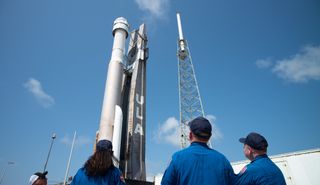How to watch Boeing Starliner's OFT-2 mission to the space station: Webcast guide
There will be many milestones to watch online.
Update: Boeing's Starliner OFT-2 spacecraft has successfully launched into orbit on a ULA Atlas V rocket to begin a crucial test flight to the International Space Station. It is expected to reach the station Friday, May 20, at 7:10 p.m. EDT (2310 GMT). Follow our live mission updates for Starliner's OFT-2 for more.
NASA's live docking webcast will begin Friday at 3 p.m .EDT (1900 GMT).
Boeing's Starliner astronaut taxi is launching Thursday (May 19) on a crucial test flight, but coverage of the mission will continue long after liftoff.
Starliner's uncrewed mission, called Orbital Flight Test-2 (OFT-2), is scheduled to begin Thursday at 6:54 p.m. EDT (2254 GMT). If all goes to plan, Starliner will lift off toward the International Space Station atop a United Launch Alliance Atlas V rocket from Florida's Cape Canaveral Space Force Station.
You can watch the launch live here at Space.com, courtesy of NASA, or directly via the space agency. Coverage will begin Thursday at 6 p.m. EDT (2200 GMT).
OFT-2 aims to demonstrate that Starliner is ready to carry humans aloft. Boeing and NASA hope that Starliner's first crewed flight occurs later this year, assuming OFT-2 meets its major objectives.
Live updates: Boeing Starliner Orbital Flight Test 2 mission to ISS
Get the Space.com Newsletter
Breaking space news, the latest updates on rocket launches, skywatching events and more!
"OFT-2 will demonstrate the end-to-end capabilities of the Starliner spacecraft and Atlas V rocket, from launch to docking to a return to Earth in the desert of the western United States," NASA stated May 12 of the launch.
"The uncrewed flight test will provide valuable data toward NASA certifying Boeing’s crew transportation system for regular flights with astronauts to and from the space station."
NASA has a lot of coverage planned in the days after the launch. Here is a rundown of what to expect and how to see it.

Thursday, May 19
6 p.m. EDT (2200 GMT Friday, May 20): Prelaunch coverage begins, with liftoff at 6:54 p.m. EDT (2254 GMT). NASA will also webcast a postlaunch news conference, which is expected to take place around 9 p.m. EDT (0100 GMT on May 20). That news conference will feature the following participants:
- Kathryn Lueders, associate administrator, NASA Space Operations Mission Directorate
- Steve Stich, manager, NASA’s Commercial Crew Program
- Joel Montalbano, manager, NASA’s International Space Station Program
- Mark Nappi, vice president and program manager, Boeing Commercial Crew Program
- John Elbon, chief operating officer, United Launch Alliance

Friday, May 20
NASA TV will start its rendezvous and docking coverage at 3:30 p.m. EDT (1930 GMT), and Starliner is scheduled to dock with the ISS at 7:10 p.m. EDT (2310 GMT). This time is approximate, however, and could change depending on how the mission is going.
Saturday, May 21
Assuming the docking proceeds to plan and on schedule, NASA TV will start hatch opening coverage at 11:30 a.m. EDT (1530 GMT). The opening of the hatches between Starliner and the ISS, along with welcoming remarks by astronauts aboard the orbiting lab, should start about 15 minutes later.
Undocking and return to Earth
NASA has not yet released timing or coverage details about Starliner's undocking and return to Earth, which will likely happen about five days after docking. But when these events occur, they will probably be webcast by NASA TV. Provided NASA has a feed available, the events will be simulcast on Space.com.
Other opportunities
If you act quickly, anyone can register to attend the launch virtually. NASA promises that those who participate will receive "curated launch resources, notifications about related opportunities or changes, and a stamp for the NASA virtual guest passport following a successful launch."
In the six hours before launch, NASA plans to broadcast a live video feed on its Kennedy Space Center newsroom YouTube channel of Space Launch Complex-41 at Cape Canaveral Space Force Station. This feed should run uninterrupted until one hour before liftoff.
Parents, child caregivers and teachers can access OFT-2 related information for children and students through NASA's Next Gen STEM Commercial Crew.
NASA also plans ongoing coverage on numerous social media channels on Twitter, Facebook and Instagram. Use the hashtag #Starliner to engage online.
Follow Elizabeth Howell on Twitter @howellspace. Follow us on Twitter @Spacedotcom and on Facebook.
Join our Space Forums to keep talking space on the latest missions, night sky and more! And if you have a news tip, correction or comment, let us know at: community@space.com.

Elizabeth Howell (she/her), Ph.D., is a staff writer in the spaceflight channel since 2022 covering diversity, education and gaming as well. She was contributing writer for Space.com for 10 years before joining full-time. Elizabeth's reporting includes multiple exclusives with the White House and Office of the Vice-President of the United States, an exclusive conversation with aspiring space tourist (and NSYNC bassist) Lance Bass, speaking several times with the International Space Station, witnessing five human spaceflight launches on two continents, flying parabolic, working inside a spacesuit, and participating in a simulated Mars mission. Her latest book, "Why Am I Taller?", is co-written with astronaut Dave Williams. Elizabeth holds a Ph.D. and M.Sc. in Space Studies from the University of North Dakota, a Bachelor of Journalism from Canada's Carleton University and a Bachelor of History from Canada's Athabasca University. Elizabeth is also a post-secondary instructor in communications and science at several institutions since 2015; her experience includes developing and teaching an astronomy course at Canada's Algonquin College (with Indigenous content as well) to more than 1,000 students since 2020. Elizabeth first got interested in space after watching the movie Apollo 13 in 1996, and still wants to be an astronaut someday. Mastodon: https://qoto.org/@howellspace
